
|   |

|   |
 e-mail: arshiyasethi@gmail.com Pioneers of Corona Creativity: Dance Films on Poetry of Hard Times, Methil Devika, Shovana Narayan and Sangeeta Chatterjee June 13, 2020 At a time when the domain of the arts is reeling with the economic impact of Corona and its devastation of livelihoods, the other buzz is around the creativity that has not ceased to pour out from the creative sector. Not just are artists being unusually deft at using technology to stay united, in conversations and 'guftagu', living up to Sardar Jafri's hope in the nazm 'Guftagu band na ho', but they are coming up with amazing creativity, in the form of online concerts, and very interestingly dance films on poetry of hard times. I must take a moment to mention here that there are some very effective music videos that have been made at this time as well, but I write here only on dance videos. I have already written in past columns about Mrinalini's video that was the first to go viral and Innee Singh's efforts that started small but grew exponentially when arts and media personality, Usha RK, who needs no introduction to Indian dance artistes, lovers and connoisseurs, became a catalyst. And she did all this while in Moscow as the Director of the Jawaharlal Nehru Cultural Centre there. In this column I write about three other pioneers in this genre, who in this short time, with no reference points as such, plunged into unchartered territories, made so much impact and created a significant body of dance work to counter Corona's crushing emotional impact and challenges. 
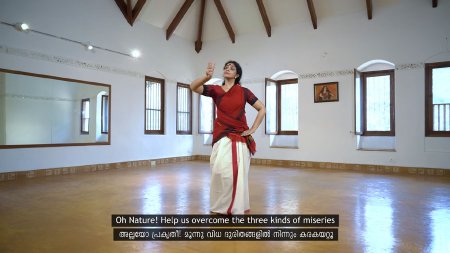
Methil Devika
One of the Corona messaging pieces to have found maximum visibility on the internet has been "Break the Chain", the piece created by Mohiniattam dancer Dr. Methil Devika, under the banner of Chitrakutam Art House. The very first thing I learnt about the Corona virus from this piece is why the virus got its name - Corona. WHO announced 'COVID-19' as the name of this new disease on 11 February 2020. 'CO' stands for corona, 'VI' for virus, and 'D' for disease. Formerly, this disease was referred to as '2019 novel coronavirus' or '2019-nCoV'. The pathogen got its name due to the spiky crown (or corona in Latin) that you can see on its surface when you take a look at it underneath a microscope. Devika uses its image to depict the demon wearing a spiky crown. The reasons for the popularity of this short dance film are many, and will be discussed later, but first for those who may not know her, Devika is a recipient of the Bismillah Khan Yuva Puruskar. She has a graduate degree in both Management and Performance Arts, topping in both fields and even winning a gold medal in the latter. She has impressed everyone with her dance work called 'Sarpatatvam', based on serpent mystique and wisdom. With her husband, well known actor Mukesh, former Chairman of the Kerala Sangeet Natak Akademi, who has a parallel political career too, as the Member of the Legislative Assembly from Kollam, she has also done a dance theatre performance in 2015, "Naga." This is an adaptation of Girish Karnad's "Nagamandala" directed by NSD alumni Suveeran. I had a telephonic conversation with Palakkad based Devika for this column. "I wasn't intending to do anything for Corona, except follow the government lockdown guidelines which were being implemented very strongly. The prompt came from a Melbourne based friend of mine, Dr. Arun A. Azeez, who first alerted me to the need to convey the messages of protection from Corona. I remember he used the term 'instructional video'. He advised me not to be too stylised and give very clear instructions", recalled Devika. This transcontinental conversation started the wheels churning in her mind. Aware that she did not have the indulgence of time, as the timeliness of the message was critical, she also knew that she could not do a bland instructional video. "It still had to have my artistic stamp and make sure of an in-depth treatment by going back to our roots," described Devika, referring to the competing pulls and pushes she was dealing with at that time. That is when she came across Muthuswami Dikshitar's Navavarna kriti, a composition, dating back to the early 18th century addressed to the Mother Goddess. In the words she saw the echoes pertinent to our times, in a way a coming together of ancient beliefs and modern scientific knowledge. "Man has been afflicted by three types of malaise, natural from society and from within, depression being an example of the last while the corona virus is an example of the first. What is important is our response to it. In this production I look at how the virus has impacted, what is the scientific knowledge that we have to counter it, and how we need to respond collectively. Then going beyond the knowledge we need to surrender ourselves to something beyond the logic, remembering to be cautious but compassionate, fearless, but respectful as we tide over it." Keeping the time factor in mind she shot it over a day in her home studio that had its own lights and suitable facilities. But her cameraman, Vipin Chandra, needed to come over to shoot, which would not have been possible because of the stringent lockdown rules, except that he being a member of the press corps had a pass that allowed him this possibility. The editor had no such privilege and so Devika had to conduct discussions with him over phones, emails and Whatsapp. The same held true for interactions with Dr. Arun in distant Australia, as he helped Devika with the subtitles. She found it possible to meet all Dr. Arun's instructions and satisfy all her concerns of being richly resonant and in depth in literary, dramatic, musical and dance arts. But then came the surprise twist. "I was ready with it in end March and I sent a copy of the piece to Shailja teacher, our Health Minister of Kerala, and left a message for her to watch it. She called me back, despite the busy schedule she was following so that Kerala could fight the virus well and become a model state in doing so. She had liked the work and was willing to endorse it by giving a message, that acknowledges the need for all people to work together to defeat the Corona virus. This serves as the prelude of the piece as it exists today," says Devika calmly except for a tone of happiness that could be deduced from her voice. "This worked in my favour, and made the piece become really popular," says Devika. Another thing that scholars, musicologists and the connoisseurs have appreciated is the fact that this composition is not usual for dance. In fact, it is unusual even for concerts since it has strong tantric symbolism as Navavarna refers to the 9 layers of the Sri Chakra yantra which is not just one of the primary modes of Devi worship, but also representational of the Devi. "Famous singer K.S. Chitra put it up on her FB page remarking about this exact thing," informs Devika. Another aspect that accounts for its popularity is the slickness of production values, which others have found hard to achieve under the lockdown restrictions. And the final reason for its popularity is one that Devika herself pointed out to me, incisively reading the Indian mind. "The theme is of today but the knowledge is coming from yore. We clutch things in which the yore comes to the fore." Well said, Devika. She promises that she has other things, creative dance films in the process waiting to come out soon, including a love story in the time of quarantine. We await it eagerly. 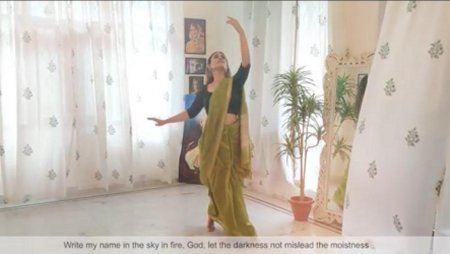
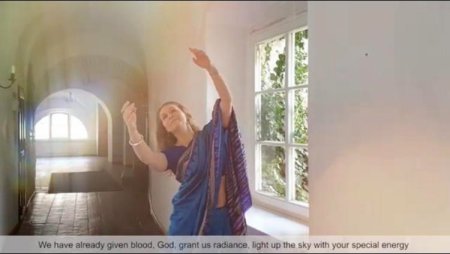
Disciples of Shovana Narayan
Renowned Kathak dancer Shovana Narayan, foremost disciple of Pt. Birju Maharaj, recipient of the Sangeet Natak Award and the Padmashri for her individual solo dance, group choreographies and scholarly contributions to dance and the pantheon of amazing disciples that she has taught, is "an avid poetry reader in English, Hindi, Urdu, where the Urdu is in devnagari script, and a smattering of Sanskrit", to quote her own words. When she says Hindi, it incorporates the entire range of poetry written in the devnagari script but includes Maithili, Awadhi and Bhojpuri. She knows and reads in German as well since she is married for almost four decades to Austrian diplomat Herbert Traxl, who served a term as Austria's Ambassador to India. Like Devika, she too made a clutch of dance films early in the period of the lockdown, and in that sense she is a pioneer in this genre too. Shovana knows her poetry well. You can do this kind of a range of poets and languages and find exactly what fits the theme, is only possible when you know your work. In the past too, she has worked on an extensive range of poetry, from Maithili Sharan Gupt's 'Yashodhra' to Tagore and even the poetry of Guru Gobind Singh. In this period of the lockdown, she came up with four dance videos that captured the emotions of what the world was feeling due to the anxiety and uncertainties of the Corona pandemic. "I call it 'hard time poetry,'" she says with her trademark smile that I can hear over the phone. "I did it between mid April to mid May." Not for her anything instructional, but reflective, insightful and motivational. It was World Dance Day this year, when I saw the first poem from the Asavari stable - the dance institute established by her - based on Rashtra Kavi Ramdhari Singh Dinkar's "Aag ki Bheekh". Dinkar is one of my favourite poets and that point alone could well be the reason for my bias, or the fact that it featured a clutch of her disciples, some of Asavari's best products, including dancer-painter Shruti Gupta Chand, Shovana's very first disciple, and Mrinalini, the dancer who danced the first piece I had seen during the lockdown and about whom I wrote in an earlier column. These were also some of those disciples who were with her every day for online classes during the period of lockdown. The daily interaction made it possible to work fast to come up with this video. A powerful poem, "Aag ki Bheekh" dwells on the plea that mankind has to shrug off all apathy and rejuvenate itself with renewed energy and determination to tackle all challenges of life, without ever losing sight of the larger good of mankind and humanity, and dare we say, including for those who are at the forefront of this challenging battle. It talks of darkness and foggy pathways, obliquely referring to the depression, sadness and loneliness that has become part and parcel of the Corona pandemic. The poem is powerfully recited by Shovana herself with the music set by Madho Prasad, who comes in one of the closing frames of the video, just before the credit roll. 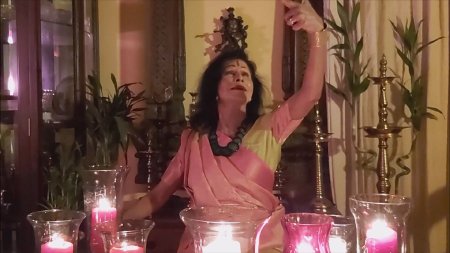 Shovana Narayan In the dance video based on the nazm "Guftagu band na ho" by pioneer of the Progressive Writers Movement, Ali Sardar Jafri, Shovana surrounded by glittering shamas, performs solo to the rendering of the evocative nazm by the poet himself, taken from the recording of an old All India Radio Mushaira. In this piece, Shovana continues further on the theme of depression and does not just describe it, or exhort to go beyond it, but Shovana actually builds on the poet's words to prescribe a way out. "Don't let the conversations cease," says Jafri. "One word leading to another. The evening rendezvous lasting till dawn. The starry night laughing down with us." Acknowledging that the issue is a pervasive one, especially among senior citizens who find themselves helpless without support and who feel isolated as their children, relatives and friends are unable to see them or render any assistance, the need for communication, therefore, becomes paramount. When Sardar wrote this nazm, there is no doubt that he had other things on mind and not the lockdown or the corona virus, but the ideas fitted in perfectly. The dancer and the poet both urge that conversations must never cease and the main reason is that conversations, communications, listening, speaking, hearing, all make one feel wanted - "keeping our heart warm and beating" as the translation says. "Today it is COVID. Tomorrow it could be something else. Intensities of diseases are increasing and so is its geographical spread. This is a mantra we need to follow, a need to make positivity a part of ourselves," says the contagiously exuberant Shovana. In Gopal Das Neeraj's poem, "Mere Desh udas na ho" the poem reiterates the inevitable that after a dark night a new day will dawn. To get through the night you may need to light a lamp. With the promise of the coming day that this lamp carries, we will tide over the worst. It is a strong message of hope, something that we need when the shadow of the Corona virus is so pronounced not just in all of India but all the world. There is nowhere to hide and so we have to face it and allow it to pass. "We cannot afforest to be apathetic and indulgent without fears. We have to fight them consciously. We come from a culture that tells stories of asuras and devas to the children every day. It is the dharma of the devas to fight the asura, just as it is mankind's dharma to fight the fearful, the unknown, the threatening. This is what I have tried to portray through my abhinaya in the piece. We already have all the tools to deal with the emotional end of this pandemic. My dance serves as a reminder," claims Shovana. She really believes in the need to reiterate the message, for this again is the theme of her abhinaya to Lisa Marks' poem "Just Wait for the Sun". This is a poem written in the time of Corona and consequently is the only one from among the four dance films based on poems, created during the period of the lockdown, to bear a link with the current scenario. 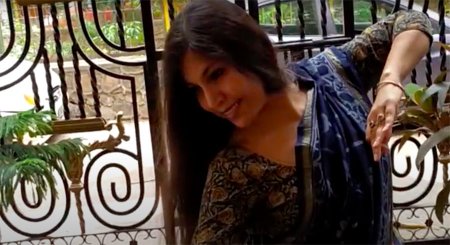
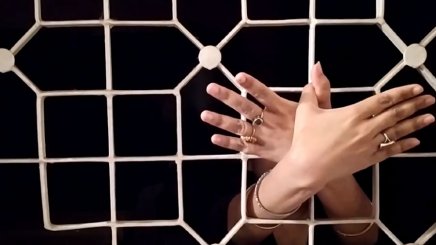
Sangeeta Chatterjee
A film that impressed me very much was "Quest: A Lockdown Diary of a Dancer" made by Kathak dancer Sangeeta Chatterjee, a disciple of Vaswati Misra, who has inherited an intellectual curiosity from her Guru apart from her lessons in the dance. Vaswati herself is known for her thinking approach and that thinking quotient she has transferred to Sangeeta. Sangeeta runs her Kalpataru Arts Institute where she teaches and choreographs performances as well as prepares her own solo work. Recently she presented 'Yajnaseni' - The ultimate Oblation in Kathak, based on the Odia novel Yajnaseni by the Gyanpeeth awardee Dr. Pratibha Ray. Honestly, Sangeeta admitted that she read only its English translation in our conversation. The story revolves around Draupadi, who is also known as Yajnaseni and it is a neo-interpretation of Mahabharata from Yajnaseni's perspective. Sangeeta is evidently attracted to literature which is the performative spine of Kathak. On the occasion of the visit to India, of Bangladesh premier Sheikh Hasina in 2016, she choreographed a production "Hridoy Majhe Bangla," featuring as many as thirty dancers and musicians, that was showcased at the Rashtrapati Bhawan. Based on Bengali literature emerging from the two countries, the production not only highlighted the philosophical synthesis of two national poets (Ravindranath Tagore & Kazi Nazrul Islam) but also featured the works of less iconic poets like Jibanand Das and Zillur Rehman Siddique. One of the highlights in her recent career has been her work with a Japanese Nihon Buyo dance group. Nihon Buyo is a refined, storytelling dance genre in Japan and has some commonality with Kathak. The group of Goyokai Nihon Buyo dancers has engaged with Sangeeta for three years, and has resulted in the production of the Ramayan story in that style, with inputs and participation of Sangeeta and her group in 2018 in Kamani in Delhi, and with just her in Japan in 2019. I tell you all this to highlight the fact that till she came out with 'Quest', Sangeeta had not even dabbled with film. So what made her inclined to filming dance and that too in a non linear fashion, in abstraction. "Quest" she told me in our conversation, "came out very organically". The suddenness and comprehensiveness of the lockdown announcement, caught her by surprise at it had caught so many others and ignited questions in her mind. "Everything seemed fragile and uncertain. Everything that once we craved for suddenly seemed unimportant. At this juncture of life, I being a dancer went through intense confrontation with myself as an artiste and hence a quest began.... Why do I dance? Do I dance to impress, express or maybe at times to suppress my feelings? Where does it begin? Is it my physical body which does this as a chore or it lies somewhere else? How does a current situation like this impact my dance?" were just some of the questions that plagued Sangeeta. "The overwhelming load of domestic chores seemed to be distancing me from my dance," she recalled. "You know they say that when there is bad news people react in three ways- they either freeze, flee or fight. I seemed to be freezing". There was just no desire to dance, but while many dancers may have initially felt dejected, soon most bounced back. "I was seeing around me, immense activity by dancers online, and wondering what was happening to me," she explained. "I was getting sucked into domesticity, and by the second lockdown I felt I was in a vacuum. This feeling was familiar. There was a sense of déjà vu. I had felt exactly like this when I had taken a nine month break during my pregnancy. I realised why this vacuum was bothering me. Dance is my state of being. I don't need a reason to dance." One day as Sangeeta was standing near a grilled window, she stuck her hand out and made some dance movements. She asked her husband to take some images from outside. They looked powerful. Over the next fifteen days she walked all over her house dancing in unexpected corners and unplanned settings. "This was all a spontaneous response to the current state of mine." She kept documenting these forays into intimate domestic spaces in small clips. "Because it was not choreographed, it was not dance being presented, as it is on a formal stage, but was a reflection of dance as a way of life. I still had no plans of making a film or anything like that. But one day, I impulsively sent my clips to an old friend Lubdhak Chatterjee, to see what was possible with it." For those of you who may not know, Lubdhak is a brilliant young independent film maker who is qualified as an engineer, when he discovered his passion for photography and film making. He integrated with this passion an older love for classical Indian music and dance. He debuted with the 2018 documentary 'Vaikhari'. This won him the Doordarshan Film Fellowship and the film was screened at various festivals globally. His next film 'Aahuti' (2019), inspired by a ritualised choreography of the hands, was released at the International Film Festival of Rotterdam in February 2020. Lubdhak can see possibilities in dance, where many others can't. On receiving these clips, he saw something and created a rough cut for Sangeeta. "I gave my reaction to him in the form of an audio clip sent over from my phone. He edited it and laid it under, and then things started to take a definite shape", recalls Sangeeta about how this film took shape. "In 'Quest' I wanted to see if dance for me had really gone beyond the performance to have become my daily vocabulary." Leading dance critic and commentator Leela Venkataraman, in her weekly roundup of dance remarked about the film that, "While the concept of filming on a phone camera... speaks of her poetic sensitivity, one is struck by the editing work, the minimalistic aesthetic approach and the wonderful way Nature and dancer are brought together." So is the film just an experiment in the time of COVID, I ask, or does it carry a deeper signature. "Today we have no stage. COVID has seen to that. So, every place I danced at was not just an expression of dance getting truly inside me, but it took my dance beyond the stage. It made everywhere I danced, the sacred space of the stage. It was a realisation, a cleansing, a defiance. A defiance of the restrictions that COVID could place on my dance! It broke previously held restrictions of my thought. I used traditional metaphors to express unconventional aspects. I used the motif of the 'alingan', an image of intimacy, to suggest the criticality of physical distancing. What became clear to me at the end of Quest was that dance does not exist only in the perfections of life. Rather it breathes, and allows you to breathe, in the imperfections too."  Dr. Arshiya Sethi, trained in Kathak, has served as dance critic, commentator, institution builder for the arts, having created both tangible and intangible institutions and equities. She has been a Fulbright Arts Fellow (2003-2004) and a post doctoral Fulbright (2016-2017). Her doctoral work has been on the link between politics and dance in the case of Sattriya. She is presently working on the intersection of dance and activism / social justice through her NGO, Kri Foundation (estd. 2003), and has extended her academic work to Indian dance in the diaspora. Post your comments Please provide your name and email id when you use the Anonymous profile in the blog to post a comment. All appropriate comments posted with name & email id in the blog will also be featured in the site. |